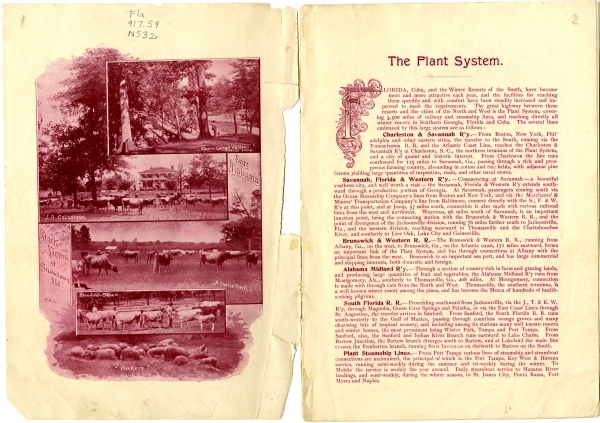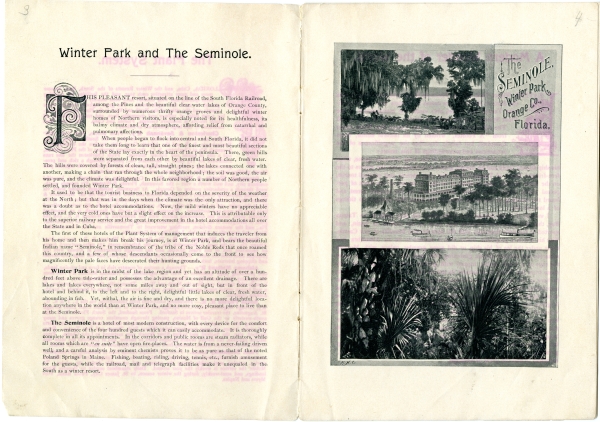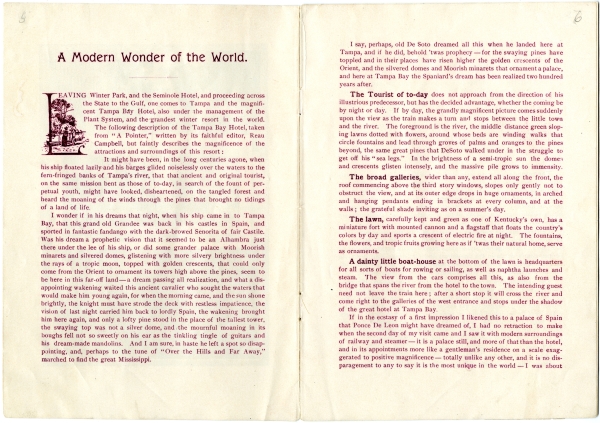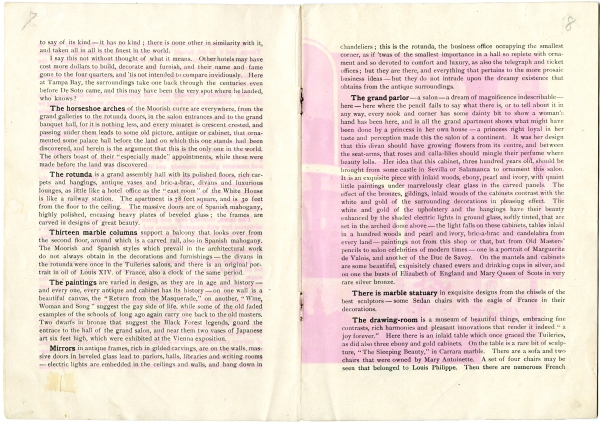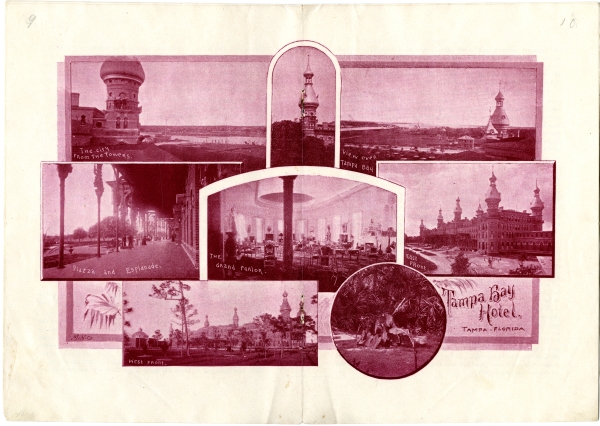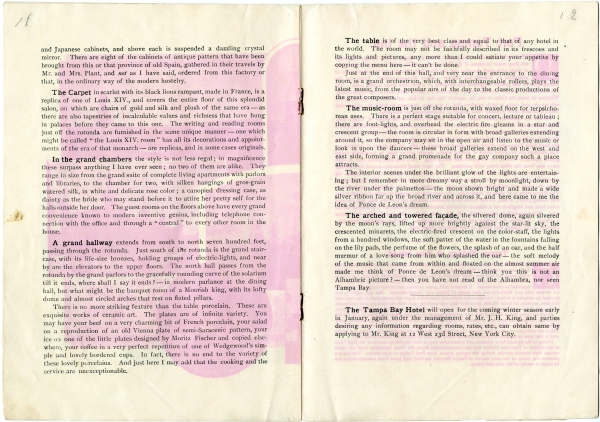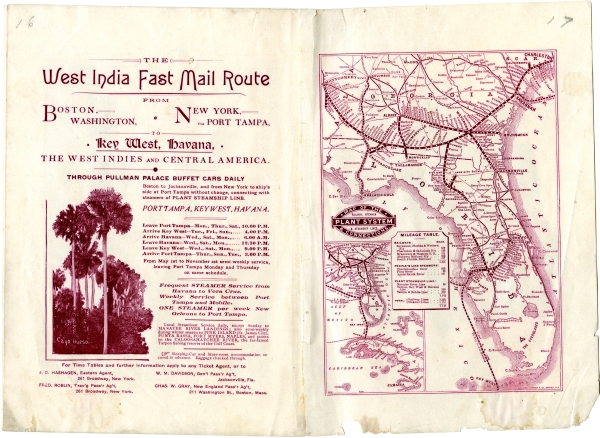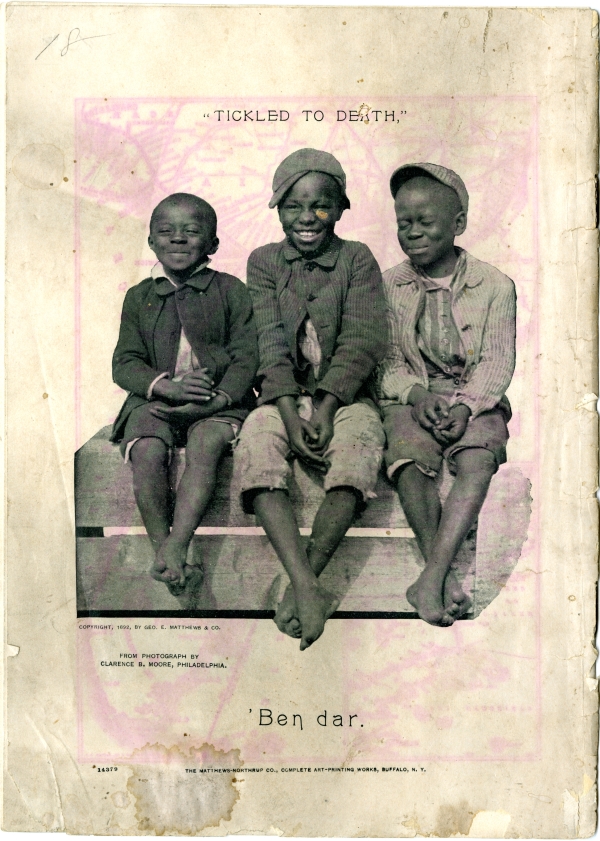Florida Memory is administered by the Florida Department of State, Division of Library and Information Services, Bureau of Archives and Records Management. The digitized records on Florida Memory come from the collections of the State Archives of Florida and the special collections of the State Library of Florida.

State Archives of Florida
- ArchivesFlorida.com
- State Archives Online Catalog
- ArchivesFlorida.com
- ArchivesFlorida.com
State Library of Florida
Related Sites

Description of previous item
Description of next item

Leaflet advertising the Plant System's Overland and Short Sea Route, ca. 1892
Source
Description
Date
Publisher
Format
Topic
Subjects
THE NEW OVERLAND and SHORT SEA ROUTE
FROM THE NORTH AND WEST, THROUGH FLORIDA TO THE GULF OF MEXICO, AND ON TO CUBA,
.. VIA ..
THE PLANT SYSTEM
Title
Subject
Source
Publisher
Date
Format
Language
Type
Identifier
Coverage
Geographic Term
Thumbnail
Display Date
ImageID
topic
Subject - Corporate
Transcript
THE NEW OVERLAND and SHORT SEA ROUTE
FROM THE NORTH AND WEST, THROUGH FLORIDA TO THE GULF OF MEXICO, AND ON TO CUBA,
.. VIA ..
THE PLANT SYSTEM
The Plant System.
FLORIDA, Cuba, and the Winter Resorts of the South, have become more and more attractive each eyar, and the facilities for reaching them speedily and with comfort have been steadily increased and improved to meet the requirements. The great highway between these reosrts and the cities of the North and West is the Plant System, covering 3,500 miles of railway and steamship lines, and reaching directly all winter resorts in Souther Georgia, Florida and Cuba. The several lines embraces by this large system are as follows:
Charleston & Savannah R'y.- From Boston, New York, Philadelphia and other easern cities, the traveler to the South, coming via the Pennsylvania R.R. and the Atlantic Coast Line, reaches the charleston & Savannah R'y at Charleston, S.C., the northern terminus of the Plant System, and a city of quaint and historic interest. From Charleston the line runs southward for 115 miles to Savannah, Ga., passing through a rich and prosperous farming country, abounding in cotton and rice fields, with adjacent pine forests yielding large quantities of turpentine, rosin, and other naval stores.
Savannah, Florida & Western R'y.- Commencing at Savannah - a beautiful souther city, and well worth a visit - the Savannah, Florida & Western R'y extends southward through a productive portion of Georgia. At savannah, passengers coming south via the Ocean Steamship Company's lines from Boston to New York, and via the Merchant's & Miner's Transportation Company's line from Baltimore, connect directly with the S., F. & W. R'y at this point, and at Jesup, 57 miles south, connection is also made with various railroad lines from the west and northwest. Waycross, 96 miles south of Savannah, is an important junction point, being the connecting station with the Brunswick & Western R.R., and the point of divergence of the Jacksonville division, running 76 miles father south to Jacksonville, Fla., and the western division, reaching westward to Thomasville and the Chattachoochee River, and southerly to Live Oak, Lake City and Gainesville.
Brunswick & Werstern R.R. - The Brunswick & Western R.R., running from Albany, Ga., on the west, to Brunswick, Ga., on the Atlantic coast, 171 miles eastward, forms an important link of the Plany System, and has through connections at Albany with the principal lines from the west. Brunswick is an important sea port, and has large commercial and shipping interests, both domestic and foreign.
Alabama Midland R'y. - Through a section of country rich in farm and grazing lands, and producing large quantities of fruit and vegetables, the Alabama Midlan R'y runs from Montgomery, Ala., southerly to Thomasville, Ga., 208 miles. At Montgomery, connection is made with through cars from the North and West. Thomasville, the southern terminus, is a well known winter resort among the pines, and has become the Mecca of hundreds of health seeking pilgrims.
South Florida R.R.- Proceeding southward from Jacksonville, via the J., T. & K. W. R'y, through Magnolia, Green Cove Springs and Palatka, or via the East Coast Lines through St. Augustine, the traveler arrives in Sanford. From Sanford, the South Florida R.R. runs south-westerly to the Gulf of Mexico, passing through countless orange groves and many charming bits of tropical scenery, and including among its stations many well known resorts and winter homes, the most prominent being Winter Park, Tampa and Port Tampa. From Sanford, also, the Sanford and Indian River Branch runs eastward to Lake Charm. From Bartow Junction, the Bartow branch diverges south to Bartow, and at Lakeland the main line crosses the Pemberton branch, running from Iverness on the north to Bartow on the South.
Plant steamship Lines.- From Port Tampa various lines of steamship and steamboat connections are maintained, the principal of which is Port Tampa, Key West & havana service, running semi-weekly during the summer and tri-weekly during the winter. To Mobile, the service is weekly the year around. Daily steamboat service to Manatee River landings and semi-weekly, druing the winter season, to St. James City, Punta Rassa, Fort Myers and Naples.
Winter Park and The Seminole.
THIS PLEASANT resort, situated on the line of the South Florida Railroad, among the Pines and the beautiful clear water lakes of Orange County, surrounded by numerous thrifty orange groves and delightful winter homes of Northern visitors, is especially noted for its healhfulness, its balmy climate and dry atmosphere, affording relief from catarrhal and pulmonary affections.
When people began to flock into central and South Florida, it did not take them long to learn that one of the finest and most beautiful sections of the State lay exactly in the heart of the peninsula. There, green hills were separated from each other by beautiful lakes of clear, fresh water. The hills were covered by forests of clean, tall, straight pines; the lakes connected one with another, making a chain that ran through the whole neighborhood; the soil was good, the air was pure, and the climate was delightful. In this favored region a number of Northern people settled, and founded Winter Park.
It used to be that the tourist business to Florida depended on the severity of the weather at the North; but that was in the days when the climate was the only attraction, and there was a doubt to the hotel accomodations. now, the mild winters have no appreciable effect, and the very cold ones have but a slight effect on the increase. This is attributable only to the superior railway service and the great improvement in the hotel accomoadations all over the State and in Cuba.
The first of these hotels of the Plant System of management that induces the traveler from his home and them makes him break his journey, is at Winter Park, and bears the beautiful Indian name "Seminole," in remembrance of the tribe of the Noble Reds that once roamed this country, and a few of whose descendants occasionalyl come to the front to see how magnificently the pale faces have descrated their hunting grounds.
Winter Park is in the midst of the lake region and yet has an altitude over a hundred feet above tide-water and possesses the advantage of excellent drainage. there are lakes and lakes everywhere, not some miles away and out of sight, but in front of the hotel and behind it, to the left and to the right, delightful little lakes of clear, fresh water, abounding in fish. yet, withal, the air is fine and dry, and there is no more delightful location anywhere in the world than at Winter park, and no more cosy, pleasant palce to live than at the Seminole.
The Seminole is a hotel of most modern construction, with every device for the comfort and convenience of the four hudnred guests which it can easily accommodate. It is thoroughly complete in all its appointments. In the corridors and public rooms are steam radiators, while all rooms which are "en suite" have open fire-pleaces. The water is from a never-failing driven well, and a careful analysis by eminent chemists proves it to be as pure as that of the noted Polan Springs in Maine. Fishing, boating, riding, driving, tennis, etc., furnish amusement for the guests, while the railroad, mail and telegraph facilities make it unequaled in the south as a winter resort.
The Seminole Winter Park, Orange co., Florida.
A Modern Wonder of the World.
LEAVING Winter Park, and the Seminole Hotel, and proceeding across the State to the Gulf, one comes to Tampa and the magnificent Tampa Bay Hotel, also under the management of the Plant System, and the grandest winter resort in the world. The following description of the Tampa Bay Hotel, taken from "A Pointer," written by its faithful editor, Reau Campbell, but faintly describes the magnificence of the attractions and surroundings of this resort:
It maight have been, in the long centuries agone, when his ship floated lazily and his barges gilded noiselessly over the waters to the fern-fringed banks of Tampa's river, that that ancient and original tourist, on the same mission bent as those of to-day, in search of the fount of perpetual youth, might have looked, disheartened, on the tangled forest and heard the moaning of the winds through the pines that brought no tidings of a land of life.
I wonder if in his dreams that night, when his ship cam in to Tampa Bay, that this grand old grandee was back in his castles in Spain, and sported in fantastic fandango with the dark-browed Senorita of fair Castile. Was his dream a prophetic vision that is seemed to be an Alhambra just there under the lee of his ship, or did some grander palace with Moorish minarets and silvered domes, glistening with more silvery brightness under the rays of a tropic moddn, topped with goldenc rescents, that could only come from the Orient to ornament its towers high above the pines, seem to be here in this far-off land - a dream passing all realization, and what a disappointing wakening waited this ancient cavalier who sought the waters that would make him young again, for when the morning came, and the sun shone brightly, the knight must have strode the deck with restless impatience, the vision of last night carried him back to lordly Spain, the wakening brough him here again, and only a lofty pine stood in the place of the tallest tower, the swaying top was not a silver dome, and the mournful moaning in its boughs fell not so sweetly on his ear as the tinkling tingle of guitars and his dream-made mandolins. And I am sure, in haste he left a spot so disappointing, and, perhaps, to the tune of "Over the Hills and Far Away," marched to find the great Mississippi.
I say, perhaps, old De Soto dreamed all this when he landed here at Tampa, and if he did, behold 'twas prophecy - for the swaying pines have toppled and in their places have risen higher the golden crescnets of the Orient, and the silvered domes and Moorish minarets that ornament a palace, and here at Tampa Bay the Spaniard's dream has been realzied to hundred years after.
The Tourist of to-day does not approach from the direction of his illustrious predecessor, but has the decided advantage, whether the coming be by night or day. If by day, the grandly magnificent picture comes suddenly upon the view as the train makes a turn and stops between the little town and river. The foreground is the river, the middle distance green sloping lawns dotted with flowers, around whose beds are winding walks that circle fountains and lead through groves of palms and oranges to the pines beyond, the same great pines that DeSoto walked under in the struggle to get off his "sea legs." In the brightness of a semi-tropic sun the domes and crescents glisten intensely, and the massive pile grows to immensity.
The broad galleries, wider than any, extend all along the front the roof commencing above the third story windows, slopes only gently not to obstruct the view, and its outer edge drops in huge ornaments, in arched and hanging pendants ending in brackets at every column, and at the walls; the grateful shade inviting as on a summer's day.
The lawn, carefully kept and green as one of Kentucky's own, has a minature fort with mounted cannon and a flagstaff that floats the country's colors by day and sports a crescent of electric fire at night. The fountains, the flowers, and tropic fruits growing here as if 'twas their naturla home, serve as ornaments.
A dainty little boat-house at the bottom of the lawn is headquarters for all sorts of boats for rowing or sailing, as well as naphtha launches and steam. The view from the cars comprises all this, as also from the bridge that spans the river from the hotel to the town. The indending guest need not leave the train here; after a short stop it will cross the river and come right to the galleries of the west entrance and stops under the shadow of the great hotel at Tampa Bay.
In the ecstasy of a first impression I likened to this palace of Spain that Ponce De Leon might have dreamed of, I had no retraction to make when the second day of my visit came and I saw with modern surroundings of railway and steamer - it is a palace still, and more of that than the hotel, and in its appointments more like a gentleman's residence on a scale exaggerated to positive magnificence - totally unlike any other, and it is no disparagemtn to any to say it is the most unique in the world - I was about
to say of its kind - it has no kind; there is none other in similarity with it, and taken all in all is the finest in the world.
I say this not without thought of what it means. Other hotels may have cost more dollars to build, decorate and furnish, and their name and fame gone to the four quarters, and 'tis not intended to compare invidiously. Here at Tampa Bay, the surroundings take one back through the centuries even before De Soto came, and this may have been the very spot where he landed, who knows?
The horseshoe arches of the Moorish curver are everywhere, from the grand galleries to the rotunda doors, in the salon entrances and to the grand banquet hall, for it is nothing less and every minaret is crescent crested, and passing under them leads to some old picture, antique or cabinet, that ornamented some palace hall before the land on which this one stands had been discovered, and herein is the argument that this is the only one in the world. The others boast of their "especially made" appointments, while these were made before the land was discovered.
The rotunda is a grand assembly hall with this polished floors, rich carpets and hangings, anqitue vases and bric-a-brac, divans and luxurious lounges, as little like a hotel office as the "east room" of the White House is like a railway station. The apartment is 78 feet square, and is 30 feet from the floor to the ceiling. The massive doors are of Spanish mahogany, highly polished, encasing heavy plates of beveled glass; the frames are carved in designs of great beauty.
Thirteen marble columns support a balcony that looks over from the second floor, around which is a carved rail, also in Spanish mahogany. The Moorish and Spanish styles which prevail in the architectural work do not always obtain in the decorations and furnishings - the divans in the rotunda were once in the Tuileries salons, and there is an original portrait in oil of Louis XIV, of France, also a clock of the same period.
The paintings are varied in deisgn, as they are in age and history - and every one, every antique and cabinet in history - on one wall is a beautiful canvas,, the "Return from the Masquerade," on another, "Wine, Woman and Song" suggest the gay side of life, while some of the old faded examples of the schools of long ago carry one back to the old masters. Two dwarfs in bronze that suggest the Black Forest legends, guard the entrance to the hall of the grand salon, and near them two vases of Japanese art six feet high, which were exhibited at the Vienna exposition.
Mirrors in antique frames, rich in gilden carvins, are on the walls, massive doors in beveled glass lead to parlors, halls, libaries and writing rooms - electric lights are embedded in the ceilings and walls, and hang down in chandeliers; this is the rotunda, the business office occupying the smallest corner, as it 'twas the smallest importance in a hall so replet with ornement and so devoted to comfort and luxiry, as also the telegraph and ticket officesl but they are there, and everything that pertains to the more prosaic business ideas - but they do not intrude upon the dreamy existence that obtains from the antique surroundings.
The grand parlor- a salon- a dream of magnificence indescribable - here - where the pencil fials to say what there is , or to tell about it in any way, every nook and corner has some dainty bit to show a woman's hand has been there, and in all the grand apartment shows what might have been done by a princess in her own house - a princess right loyal in her taste and perception made this the salone of a continent. It was he design that this divan should have growing flowers from its centre, and between the seat-arms, that roses and calla-lilies should mingle their perfume where beauty lolls. Her idea that his cabinet, three hundred years old, should be brought from some castle in Sevilla or Salamanca to ornament this salon. It is an exquisite piece with inlaid woods, ebony, pearl, and ivory, with quaint little paintings under marvelously clear glass in the carved panels. The effect of the bronzes, gildings, inlaid woods of the cabinets contrast with the white and gold of the surrounding decorations in pleasing effect. The white and gold of the upholstery and the hangings have their beauty enhanced by the shaded electric lights in ground glass, softly tinted, that are set in the arched dome above - the light falls on these cabinets, tables inlaid in a hundred woods and pearl and ivory, bric-a-brac and candelabra from every land - paintings not from this shop or that, but from Old Masters' pencils to salon celebrities of modern times - one is a portrait of Marguerite de Valois, and another of the Duc de Savoy. On the mantels and cabinets are some beautiful, exquisitely chased ewers and drinking cups in sikver, and one of the busts of Elizabeth of England and Mary Queen of Scots in very rare silver bronze.
There is marble statuary in exquisite designs from the chisels of the best sculptors - some Sedan chairs with the eagle of France in their decorations.
The drawing-room is a museum of beautiful things, embracing fine contrasts, rich harmonies and pleasant innovations that render it indeed "a joy forever." Here there is an inlaid table which once graded the Tuileries, as did also three ebony and gold cabinets. On the table is a rare bit of sculpture, "The Sleeping Beauty," in Carrara marble. There are a sofa and two chairs that were owned by Mary Antoinette. A set of four charis may be seen that belonged to Louis Philippe. There are numerous French [break]
[continued] and Japanese cabiets, and above each is suspended a dazzling crystal mirror. There are eight of the cabinets of antique patter than have been brought from this or that province of old Spain, gathered in their travels by Mr. and Mrs. Plant, and not as I have said, ordered from this factory or that, in the ordinary way of the modern hostelry.
The Carpet in scarlet with its black lions rampant, made in France, is a replica of one of Louis XIV, and covers the entire floor of this splendid salon, on which are chairs of gold and solk and plush of the same era - as there are also tapestries of incalculable values and richness that have hung in palaces before they came to this one. The writing and reading rooms just off the rotunda and furnished in the same unique manner - one which might be called "the Louis XIV room" has all its decorations and appointments of the era of that monarch - are replicas, and in some case originals.
In the grand chambers the style is not less regal; in magnificence these surpass anything I have ever seen; no two of them are alike. They range in size from the grand suite of complete living apartments with parlors and libraries, to the chamber for two, with silken hangings of gros-gain watered silk, in white and delicate rose color; a canopied dressing case, as dainty as the bride who may stand before it to attire her pretty self for the halls outside her door. The guest rooms on the floors above have every grand convenience known to modern inventive genius, including telephone connection with the office and through a "central" to every other room in the house.
A grand hallway extends from south to north seven hundred feet, passing through the rotunda. Just south of the rotunda is the grand staircase, with its life-size bronzes, holding groups of electric-lights, and near by are the elevators to the upper floors. The north hall passes from the rotunda by the grand parlors to the gracefully rounding curve of the solarium till it ends, where shall I say it ends? - in modern parlance at the dining hall, but what might be the banquet room of a Moorish king, with its lofty dome and almost circled arches that rest on fluted pillars.
There is no more striking feature than the table porcelain. These are exquisite works of ceramic art. The plates are of infinite variety. You may have your beef on a very charming bit of French porcelain, your salad on a reproduction of an old Vienna plate of semi-Saracenic pattern, your ice on one of the little plates designed by Moritz Fischer and copied elsehwer, your coffee in a very perfect repetition of one of the Wedgewood's simple and lovely bordered cups. In fact, thee is no end to the variety of these lovely porcelains. And just here I may add that the cooking and the service are uneceptionable.
The table is of the very best class and equal to that of any hotel in the world. The room may not be faithfully described in its frescoes and its lights and pictgures, any more than I could satiate your appetite by copying the menu here - it can't be done.
Just at the end of this hall, and very near the entrance to the dinign room, is a gran orchestrion, which, with interchangeable rollers, plays the latest music, from the popular airs of the day to the classic productions of the great composers.
The music-room is just off the rotunda, with waxed floor for terpsichorean users. There is a perfect stage suitable for concert, lecture or tableau; there are foot-lights, and overhead the electric fire gleams in a star and crescent group - the room is circular in form with broad galleries extending around it, so the company may sit in the open air and lsiten to the music or look in upon the dancers - these broad galleries extend on the west and east side, forming a grand promenade for the gay company such a place attracts.
The interior scenes under the brilliant glow of the lights are entertaining; but I remember in more dreamy way a stroll by moonlight, down by the river under th palmettos - the moon shown bright and made a wide silver ribbon far up the broad river and across it, and here came to me the idea of Ponce de Leon's dream.
The arched and towered facade, the silvered dome, again silvered by the moon's rays, lifted up more brightly against the star-lit sky, the crescented minarets, the electric-fired crescent on the color-staff, the lights from a hundred windows, the soft patter on the water in the fountains falling on the lily pads, the perfume of the flowers, the splash of an oar, and the half murmur of a love song from him who splashed the oar - the soft melody of the music that came from within and floated on the almost summer air made me think of Ponce de Leon's dream - think you this is not an Alhambric picture? - then you have not read of the Alhambra, nor seen Tampa Bay.
The Tampa Bay Hotel will open for the coming winter season early in January, again under the management of Mr. J.H. King, and parties desiring any information regarding rooms, rates, etc., can obtain same by applying to Mr. King at 12 West 23d Street, Ney York City.
Winter Tour of Three Countries.
THE Steamships Mascotte and Olivette perform the service between Port Tampa, Key West and Havana, carrying the United States and West India Mails. During the fall, winter, and spring seasons the service is tri-weekly; during the summer the schedule provides for semi-weekly departures.
These steamships were built specially for the passenger service; the state rooms are large and airy, and are provided with incandescent electric lights and bells. Perfect ventilation is secure in all parts of the ships.
Safety, speed and comfort werhe the prime considerations in their construction, and no expense has been spared to attain these results.
The Voyage Across the Gulf. Tampa Bay, that splendid land-locked harbor, possesses that rare feature in Southern harbors - deep water. It is about 20 miles from the Line's docks at Port Tampa to the bar at Egmont Key, upon which the lighthouse stands. From Egmont Key the course is direct to Key West, distance 230 miles. A stop of several hours is made of Key West, "The Island City," and passengers find much to interest them during their short stay. Its commercial interests are important; its inhabitants are largely foreign, and many quant and curious customs are to be seen. The Russell House is the leading hotel.
The distance to Havana being only 101 miles from Key West, the departure of the ships from that point is made late at night, and the schedule so arranged as to enter the beautiful harbor of Havana at the signal of the sunrise gun of Moro Castle.
The Approach to Havana, and the entrance to Havana, with the "Moro Castle" and the "Cabana" fortifications upon the left, and the "Castillo de la Punta" upon the right, is very picturesque, and is of continual and increasing interest. From the signal tower of the "Moro" our own "Stars and stripes" and the private signal of the Line may be seen fluttering in the morning breeze.
The Interpreters of the hotels meet the ships on arrival in the bay and attend to all details incident to the landing, both passengers and baggage being quickly conveyed to the hotel selected. To the interpeters, for their gentlemanly and attentive service, is due much of the comfort and enjoyment to be found during a stay in the city.
Exchange of Money. Letters of Credit, or New York Exchange can be negotiated at any of the hotels, or at the office of Messrs. Lawton Brothers, Bankers and Agents of the Plant Steamship Line, No. 35 Mercaderes Street. Travelers are at liberty to have their mail forwarded to "care of Messrs. Lawton Brothers," and previous to the day of departure should request that their accommodations upon the steamship be reserved.
The Vicinity of Havana is one of remarkable beauty and much interest. Steam ferries, street cars and stage lines within easy access the suburbs of Regla, Cerro and Jesus del Monte, also the Castillow del Principe and the beautiful Colon Cemetery.
Fine roadwats and suburban trains shorten the distance to the villages of Carmelo, Vedado, Chorrera, Guanabacoa, Mriano and the Vente Water Works.
Permission can be easily obtained through the interpeters, and but a few hours are necessary to visit a sugar estate and witness the interesting process of sugar making.
Tourist Tickets to Havana and all points of interest on the Island of Cuba are on sale at all principal railroad ticket offices and at all offices of the Plant System in Florida; special arrangements having been made with the transporation lines for reduced rates.
Steamship Connections at Havana can be made for principal points in the West Indies, South and Central America and Mexico.
For Mexico there are frequent sailings of steamers; the War Line have a weekly service, and other lines have departures of steamers at convenient intervals, thus enabling passengers to make a long or short stay at Havana, as may be desired.
Across the Gulf of Mexico is only a ferry ride of 48 hours to Progreso; after touching at the other cities of Yucatan, Campeche and Frontera, a landing is made at Tampico and Vera Cruz, from whence the rail ride to the City of Mexico shows the finest scenery in the world, and goes through a country quite new to the American tourist, no matter if he has "been so much abroad."
From the City of Mexico, there are three lines of Pullman Cars to the Rio Grande, running through a country new and novel in the extreme - through a country of grandest scenic beauty, passing cities and towns that were cities and towns 300 years ago, yet new to the average traveler.
[Photo] PLANT STEAMSHIP CO. - STEAMER "OLIVETTE"
THE
West India Fast Mail Route
FROM
BOSTON, WASHINGTON - NEW YORK, VIA PORT TAMPA
TO
KEY WEST, HAVANA
THE WEST INDIES AND CENTRAL AMERICA
THROUGH PULLMAN AND CENTRAL AMERICA.
THROUGH PULLMAN PALACE BUFFET CARS DAILY
Boston to Jacksonville, and from New York to ship's side at Port Tampa without change, connecting with steamers of PLANT STEAMSHIP LINE.
PORT TAMPA, KEY WEST, HAVANA.
Leave Port Tampa - Mon., Thur., Sat., 10.00 P.M.
Arrive Key West - Tue., Fri., Sun.,.... 4.00 P.M.
Arrive Havana- Wed., Sat., Mon.,.... 6.00 A.M.
Leave Havana- Wed., Sat., Mon.,.... 12:30 P.M.
Leave Key West- Wed., Sat., Mon.,.... 9:00 P.M.
Arrive Port Tampa- Thur., Sun., Tue.,.... 3.00 P.M.
From May 1st to November 1st semi-weekly service, leaving Port Tampa Monday and Thursday on same schedule.
Frequent STEAMER Service from Havana to Vera Cruz.
Weekly Service between Port Tampa and Mobile.
ONE STEAMER per week New Orelans to Port Tampa.
Local Steamboat Service daily, except Sunday to MANATEE RIVER LANDING; also semi-weekly during winter season to PINE ISLAND (St. James City) PUNTA RASSA, FORT MYERS, NAPLES, and points at the CALOOSAHATCHEE RIVER, the far-famed tarpon fishing resorts of the Gulf Coast.
Sleeping-Car and State-room accommodation secured in advance. Baggage checked through.
For Time Tables and further information apply to any Ticket Agent or to
J.D. HASHAGEN, Eastern Agent, 261 Broadway, New York
W.M. Davidson, Gen'l Pass'r Ag't, Jacksonville, Fla.
FRED. ROBLIN, Trav'g Pass'r Ag't.
261 Broadway, New York.
CHAS. W. GRAY, New England Pass'r Ag't, 211 Washington St., Boston, Mass.
[MAP OF THE RAILWAY, STEAMER PLANT SYSTEM & STEAMPSHIP LINES & CONNECTIONS)
"TICKLED TO DEATH,"
Copyright, 1892, BY GEO. E. MATTHEWS & CO.
FROM PHOTOGRAPH BY CLARENCE B. MOORE, PHILADELPHIA
'Ben dar.
14379
THE MATTHEWS-NORTHRUP CO., COMPLETE ART-PRINTING WORKS, BUFFALO, N.Y.
Chicago Manual of Style
Leaflet advertising the Plant System's Overland and Short Sea Route, ca. 1892. 1892 (circa). State Archives of Florida, Florida Memory. <https://www.floridamemory.com/items/show/326740>, accessed 16 December 2025.
MLA
Leaflet advertising the Plant System's Overland and Short Sea Route, ca. 1892. 1892 (circa). State Archives of Florida, Florida Memory. Accessed 16 Dec. 2025.<https://www.floridamemory.com/items/show/326740>
AP Style Photo Citation

 Listen: The Assorted Selections Program
Listen: The Assorted Selections Program